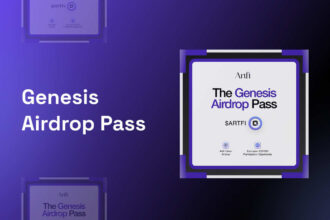In the past few years, robust development tools for building and deploying DApps have hit the market. These tools allow builders to quickly create smart contracts, design nice frontends, and rigorously test and deploy decentralized apps.
- What Is A DApp?
- Can You Build an Ethereum Dapp with Zero-Coding Experience?
- Besides Ethereum, Where Else Can You Create Decentralized Applications?
- Why Do Developers Prefer Ethereum When Deploying Dapps?
- The Top 4 Ethereum DApps
- Factors to Consider When Building Ethereum DApps
- The Cost of Building an Ethereum DApp
- Challenges of Building an Ethereum DApp
- Market Saturation
- Technology Issues
- Crypto volatility, gas fees and transaction fees
- Lack of Talent
- No clear industry regulations
- Complex User Experience
- Best Way to Start Building an Ethereum DApp
- Simplest Way to Build a DApp in Three Steps
- Conclusion
Prerequisites to building an Ethereum DApp include implementing development tools, creating robust smart contracts, designing a friendly frontend and thoroughly testing the DApp before launch.
The Ethereum DApp ecosystem is the go-to platform for most blockchain developers. As a result, the blockchain is home to 3,000+ decentralized applications. Data also suggests that Ethereum’s DEFI ecosystem accounts for $36.7 B of the $62.6B total value-locked (TVL) industry.
One of the reasons for this dominance is that most popular DApp platforms like MakerDAO, Polygon, Uniswap and Curve are natively Ethereum. As a result of this mass adoption by developers, Ethereum has grown to become the world’s largest programmable blockchain. This blockchain development tutorial walks you through the process of deploying a decentralized application (DApp) on Ethereum.
What Is A DApp?
The ability to transfer funds via cryptocurrencies is a common attribute of most DApps. For this reason, DApps have emerged as a less costly way of storing, transferring or receiving cryptocurrency. Unlike traditional applications and software, decentralized applications run on the blockchain. As such, they are powered by smart contract-enabled blockchains such as Ethereum and Solana.
In most cases, Ethereum DApps rely on the power of Web 3.0 communities to enforce a Decentralized Autonomous Organization (DAO) governance structure. In essence, this comes with the benefit of guaranteeing users a sense of control if they invest in a DApp token. Besides, the application involves the community members in key decision-making and when making significant updates.
Can You Build an Ethereum Dapp with Zero-Coding Experience?
Professional developers can find it easy to build an Ethereum Dapp. Especially if their expertise lies within software and web development.
Sound understanding of smart contracts, blockchain technology, cryptocurrencies and the solidity programming language are some of the skill prerequisites. However, it does not matter whether or not you have deep experience. With sufficient basic knowledge of programming, no-code tools can come in handy when building DApps on Ethereum. In later sections, this guide will explain how to build a DApp using Moralis and Truffle. Hang on.
Besides Ethereum, Where Else Can You Create Decentralized Applications?
Ethereum’s position as the second-born blockchain is the most preferred blockchain for deploying decentralized applications. Despite the network being in its innovative stage, developers have tried nearly all its features and tested the mainnet beyond its capabilities. However, one downside to transacting on Ethereum happens to be high gas fees. The gas fees are an important consideration for developers when comparing different programmable blockchain platforms. As such, one might wonder whether they can build a DApp on other blockchains.
3/ What is Optimism?
Optimism is a Layer 2 solution for Ethereum, the most popular Layer 1 blockchain for building dApps.
Ethereum, the first blockchain to launch with smart contracts, can be slow and expensive. But we'll get into that a bit more in the next section. pic.twitter.com/37p7avCYt7
— defizard (@belizardd) July 21, 2023Programmable smart contracts blockchains include:
- Solana
- Polkadot
- Binance Smart Chain
- Cardano
- EOS
In essence, gas fees are not the only important consideration for building robust DApps. Security, interoperability, scalability and cost are factors that can dictate the direction of decentralized applications. The best way to figure out a sound blockchain for your DApp would be to evaluate project goals, requirements and the development team’s skillset.
Why Do Developers Prefer Ethereum When Deploying Dapps?
Why do developers prefer Ethereum for deploying DApps despite high gas fees? Ethereum has 3,000+ decentralized applications in its ecosystem. The main reason why this blockchain has risen into popularity as a DApp platform is its programmability and security. Presently, the Ethereum blockchain commands one of the largest communities of developers. Additionally, the blockchain’s ecosystem features hundreds of thousands of open-source repositories for upcoming developers. Besides, the blockchain is a popular choice among business developers who want to scale their business using the Enterprise-Level blockchain initiative.
The Top 4 Ethereum DApps
- MetaMask: Metamask is a crypto-friendly decentralized application that serves both as a crypto wallet and as a gateway for connecting to the Ethereum blockchain.
- Axie Infinity: Axie Infinity is a non-fungible token (Ethereum Dapp) where players compete to build and capture an army of alien-like creatures. The game runs on the Ethereum blockchain.
- OpenSea: OpenSea is the world’s largest non-fungible tokens (NFTs) marketplace housing 2M+ NFT collections and 80M+ individual NFT sales.
- Uniswap: Uniswap is a popular decentralized exchange (DEX) and Ethereum Dapp that ranks among the most used decentralized applications in the Ethereum ecosystem. As of now, the platform has traded more than $1 trillion through its exchange.
Factors to Consider When Building Ethereum DApps
Planning is important before building any blockchain project. This is the stage where one plans out their goals and the roadmap for building, testing and deploying the DApp on Ethereum. The following elements are important considerations when planning out the DApp.
Development Environment
A development environment is vital for all types of software and applications. For a DApp, the essentials include a blockchain-based testnet upon which to build the architecture of the application. Besides, the team has to pick a robust programming language; one that aligns with their project’s requirements.
Security
Take into consideration the strength of the application’s security features. Scanty security on an Ethereum Dapp is easily catastrophic. Per year, there are over 1M+ security breach attempts into DApps. As such, it’s not advisable to take matters of cryptographic security as a joke. The team needs a deep understanding of cryptographic security to avoid falling victim to experienced hackers and scammers.
UX and UI (Frontend)
Development of the front end takes place after the completion of the app’s architecture and smart contracts. There are two significant features of the frontend, the User Interface (UI) and the User Experience (UX). The biggest challenge in the building of decentralized apps is a simple UX design that takes into account all user demographics. As such, the development team has to pay attention to usability when designing the User Interface of a DApp.
Testing and Debugging
Developers who plan to build an Ethereum DApp have to test and debug their project for any technological lags and security loopholes. In blockchain, nothing is worse than launching an application with poor usability and security bugs. Developers must ensure this is accounted for through testing and debugging before deployment.
Ethereum DApp Deployment
Pull the application out of the testnet after completing the debugging process. In this step, deploy and launch the decentralized application on the Ethereum mainnet. At this point, the sales and marketing department can take over the distribution of the DApp to the masses.
The Cost of Building an Ethereum DApp
Experienced developers can build a DApp on Ethereum with less cost. However, hiring a developer might cost an estimated $15000 for simple DApps and $30000 for more sophisticated DApps.
Challenges of Building an Ethereum DApp
Developing and deploying decentralized applications (DApp) is not without its challenges. In this section, we discuss some of them:
Market Saturation
The Ethereum DApp market is already saturated with lots of applications. For this reason, developers have to build highly competitive applications to win the market attention.
Technology Issues
Developers have to address complicated technology issues such as scalability, interoperability, security, speed and decentralization. The most important part of this process is building an application that is interoperable with other platforms. In essence, a mainstream DApp solves an inherent problem. Hence, these apps need to work seamlessly with other platforms without sacrificing security and decentralization
Crypto volatility, gas fees and transaction fees
Executing any process on a DApp and the blockchain demands paying gas fees. In Ethereum, developers pay this gas fee in Ether. High gas fees and volatility of the overal market can affect the deployment of a decentralized application.
Lack of Talent
The DApp niche and the overal blockchain industry are relatively new. As such, the industry faces a shortage of skilled talent and experienced developers. Navigating the industry is also without its challenges given its rapid dynamics.
No clear industry regulations
The crypto industry is yet to establish a set of clear regulations. For this reason, developers could face uncertainty on the direction to take their DApp.
Complex User Experience
Navigating the User Interface of DApps can be complicated compared to conventional applications. Such complications also negatively impact the development process since the team has to come up with robust applications featuring nice UI/UX.
Best Way to Start Building an Ethereum DApp
If you are a beginner wondering how to build a DApp on Ethereum quickly, the Ethereum boilerplate is the answer. It is, without a doubt, the easiest way to build dapps. By exploiting that ultimate shortcut, you can have your DApp up and running as quickly as possible. Let’s look at some of the steps:
Simplest Way to Build a DApp in Three Steps
In this section, we will outline three simple steps for building a DApp using the Ethereum Boilerplate on Moralis. These three steps are:
- Cloning Moralis Ethereum Boilerplate
- Installing the appropriate dependencies
- Deploying the Ethereum DApp
Moralis created an easy-to-use template for developers to explore building DApps. In essence, building a decentralized application using this template will contain the following features by default:
- Web3 Authentication: The DApp will support MetaMask functionality by default. Nevertheless, builders have the choice of implementing other authentication methods.
- Wallet Transactions: The completed DApp will display transactions taking place through the application’s MetaMask wallet.
- Token Transfers: Any token transfers taking place on the DApps connected wallet will show up, such transfers could be non-fungible tokens and ERC-20 tokens.
- Cross-Chain Support: Utilize the customizable features of Moralis to tweak the DApp according to the parameters you want. Remember with the Moralis platform, one can connect the DApp to any EVM-compatible blockchain.
What is Moralis
Moralis is a standard Web3 API solution provider that targets legacy developers. The provider enables blockchain developers to adopt dynamic tools for building robust DApps. Core solutions under Moralis flagship products include Auth API, Streams API and EVM API.
- EVM API: EVM abbreviates the Ethereum Virtual Machine. The EVM API acts as a data-fetching protocol between Ethereum and other EVM-compatible platforms. Developers need to use a single line of code when deploying the EVM API on Moralis.
- Streams API: Streams API allows developers to seamlessly implement webhooks. These webhooks usually scrap blockchain accounts and smart contract events to sync them with the DApp.
- Auth API: As the name suggests, the Auth API allows developers to utilize different methods of Web3 authentication, including but not limited to wallet integrations.
Apart from Ethereum, Moralis also provides an advanced Solana API. The Solana API allows you to tackle popular chains that are not compatible with the Ethereum Virtual Machine (EVM). The Moralis platform sets itself apart as a cross-compatible blockchain development solutions provider. As such, developers can build highly interoperable smart contracts using the platform’s APIs.
Step-by-Step Instructions for Deploying an Ethereum Dapp on Moralis
- Visit GitHub and clone the Ethereum boilerplate. You can find the GitHub link by searching “Ethereum Boilerplate” on Google.
- Clone the code once you find the boilerplate. Follow the screenshot below:
- Following that, establish a directory (in our case, name it “Boilerplate”) and launch it within Visual Studio Code (VSC). Subsequently, employ VSC’s terminal to duplicate the code by executing the “git clone” command, using the URL you copied in the previous step.
The following is what you will have after successfully executing step 3.
At this point, we have reached a critical step in DApp development, which involves customizing the “.env.local.example” file. This step is where we will input the necessary environmental variable values into the file.
Examining the screenshot above, you’ll notice that the uppermost variable specifies the blockchain you intend to work with. By default, the boilerplate is configured for Ethereum (0x1), which is why it’s known as the “Ethereum boilerplate.” However, you have the flexibility to connect your Ethereum DApp to other compatible EVM-based chains.
Once you’ve made your choice regarding the chain you wish to connect to and have entered the relevant chain ID, you’ll proceed to input other required values. Find the guidance on obtaining the “NEXTAUTH_SECRET” and “NEXTAUTH_URL” values in the template’s “.env.local.example” file, so you should be able to acquire these without any issues. However, you might need some assistance when it comes to obtaining your Moralis Web3 API key. In the next section, we’ll briefly explore how to obtain this key.
Obtaining a Web3 API in Moralis for Ethereum DApps
The sole requirement for obtaining your Moralis Web3 API key is having an active Moralis account. To achieve this, you can either use the “create your free Moralis account” link in the introduction or simply click on the “Start for Free” button located on Moralis’ homepage.
Now that your account is active, you can navigate to your admin area. From there, you can obtain a unique Web3 API key by following the two steps illustrated in the image below:
Next, return to your “.env.local.example” file and paste your API key alongside “MORALIS_API_KEY,” replacing the placeholder content. Once all the necessary values are in position, remember to rename the “.env.local.example” file to “.env.local”:
Proceed by installing all the necessary dependencies with the “yarn” or “npm i” command:
Lastly, you can launch your DApp by entering the “yarn run dev” or “npm run dev” command in your terminal:
Conclusion
So far, this guide has taught you how to build and deploy an Ethereum DApp. As with any efficient infrastructure for rapidly deploying applications, Ethereum has appeared enormously in this guide. However, this is not to underscore the contribution of other blockchains in the deployment of decentralized applications. However, we hope that your journey to building a decentralized application is as frictionless as possible. The DEFI ecosystem is worth a whopping $62 Billion today. We hope that you can clinch some of this value by building an application that meets the demands of the DEFI market.



















